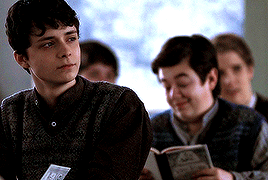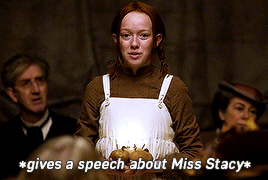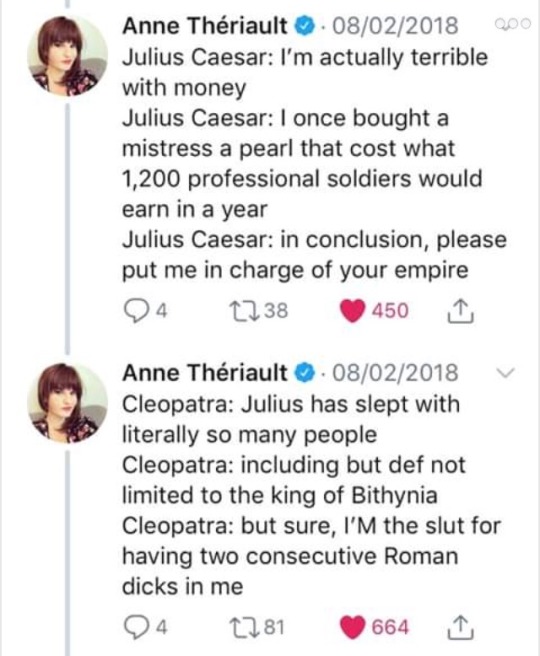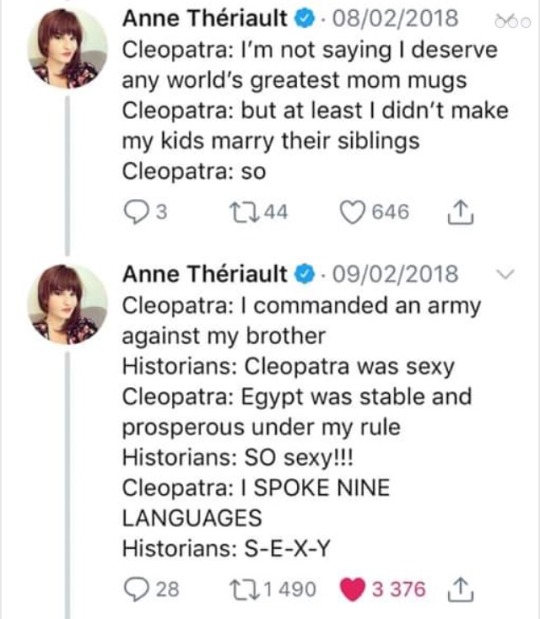scrumiere
14K posts
aries sun • capricorn moon • taurus venus • sagittarius rising • INTP • ravenclaw
Don't wanna be here? Send us removal request.
Photo








Female Rulers in Russian History
Olga of Kiev (c. 890-969) of the House of Rurik (reign as Regent: 945-964). Wife of Prince Igor, the son of Rurik, Prince of Novgorod, a founder and first ruler of the Rurik dynasty - the first ruling Russian dynasty. The marriage is fought to be initiated by Oleg the Prophet, Prince of Novgorod, Rurik’s relative and founder of Kievan Rus’. After Oleg’s death Igor assumed the rule over Kievan Rus’. Igor and Olga had one known surviving son, Svyatoslav. In 945 Prince Igor went to the tribe of the Drevlians to gather tributes and the Drevlians killed him. Upon his death Princess Olga took the powers in her hands and became regent, since her son was only 3 years old. The Princess took revenge upon her husband’s death: she buried alive matchmakers from Drevlians who came to her to propose that Olga marry their Prince Mal, then she lured their most distinguished men into a bathhouse, locked the doors and set fire to the building, burning them alive. After that she went to the land of Drevlians in order to gather tributes. The Princess asked that each household present her with a dove as a gift. Then she tied burning papers to the legs of the doves and let them fly back to their homes. As a result, the entire town was destroyed by fire. As a ruler Olga established the system of tribute gathering, which is sometimes considered to be the first legal tax system in Eastern Europe. She ordered the creation of centers of trade and taxation, divided lands into administrative units, which were controlled by the Princess’s representatives and set fixed amounts of tributes, with a detailed schedule for their gathering. Princess Olga is also thought to have been the initiator of the first stone city building in Rus’. She was first ruler of Rus’ to convert to Christianity and was baptized in Constantinople in Byzantine Empire. Her son Svyatoslav didn’t support his mother’s decision or her efforts to spread Christianity throughout Rus’ and was worried about losing the respect of the army because of Olga’s new faith, yet after her death he would bury his mother according to Christian customs. It would be Olga’s grandson, Vladimir I (also known as Saint Vladimir, Vladimir the Great or Vladimir the Fair Sun), who in 988 made Christianity the official religion of Rus’. Olga was canonized as one of the first saints of the Russian Orthodox Church and thus is known as Saint Olga.
Sophia of Lithuania (1371-1453) of the House of Rurik (reign as Regent: 1425-1432) The only daughter of ruler of Grand Duchy of Lithuania, Vytautas the Great, and wife of Vasily I, Grand Prince of Moscow, from the House of Rurik. She possibly met her future husband while he was a guest at her father’s home while still being a heir to his father, renowned Dmitry Donskoy. Sophia married Vasily in 1391 and had at least 9 children with him : 5 sons and 4 daughters. Their eldest daughter, Anna, was married to John Palaiologos, subsequently Byzantine Emperor. Their 3 sons died of plague and their youngest and last son, Vasily, was born when Sophia was 44, the birth was difficult, she got sick not long before the birth and was literally at death’s door. Throughout her marriage Sophia was a good helper to her husband both in state and economic affairs. She had a vast amount of lands in her possession and skillfully governed them. During his reign Vasily I continued reunification of the Russian lands, while dealing with the Golden Horde as the Rus’ at that time was under its dominance. Sophia’s marriage to Vasily helped to secure alliance between her husband and Grand Duchy of Lithuania and use it as prevention against severe attacks from the Golden Horde, though the alliance turned out to be fragile, and they waged war against each other at one point. Sophia tried to act as mediator between her husband and father. After Vasily’s death in 1425 Sophia became regent for their 10-year-old son Vasily II. Her husband Vasily bequeathed his wife a lot of lands into possession for life, which provided large income for Sophia and made her into even wealthier lady. She also secured the support from her father for Vasily II’s claim to the throne, as it was disputed by his uncle, Yuri of Zvenigorod. Yet in 1430 Vytautas died and from this time the ongoing battle for the throne started between Vasily II and his uncle, where Sophia would be staunchly fighting for the rights of her son. Sophia arranged marriage for her son and during wedding festivities she tore a golden belt from Vasily’s first cousin as this belt used to belong to Dmity Donskoy and Sophia believed only her son had a right to it. When her son at one point lost throne to his uncle she financed and organized public discontent against Yuri’s rule and Vasily II returned his throne; Yuri made a second attempt and managed to gain the throne for the second time, taking Sophia hostage, sending her away from Moscow, but Vasily II managed to take throne back again, Yuri died and Sophia returned. The troubles didn’t end then. When her son was captured by Golden Horde, Sophia raised an enormous sum of money as a ransom; when Vasily II was captured by his first cousin, Yuri’s son, he was blinded and became known as Vasily the Blind yet still managed to get his throne, with his mother helping to mobilize his supporters. In 1451 while her son was away Horde attacked Moscow and Sophia organized defence of the city, successfully thwarting their attack. Highly pious and devoted to Russian Orthodox Church Sophia patronized and sponsored monasteries and churches, including the famous Ascension Convent in Kremlin. She took the veil there not long before her death, leaving her vast lands to her son and her numerous grandsons as well as several religious artefacts. Sophia’s grandson, Ivan III (also known as Ivan the Great), ended the dominance of Golden Horde over Rus’, gathered Russian lands, significantly expanding the territory under his rule and carried out effective reforms, laying foundation for the powerful state.
Elena Glinskaya (c.1508-1538) of the House of Rurik (reign as Regent: 1533-1538) Daughter of Prince Vasili Glinsky, a noble from the Grand Duchy of Lithuania, and his wife Serbian Princess Anna Jakšić. Her uncle was powerful and wealthy Michael Glinsky, who began an armed rebellion against Sigismund I, Grand Duke of Lithuania. The rebellion failed and Glinsky family retreated to Russia, where Michael served Vasily III of Russia (son of Ivan III the Great). In 1525 Vasily III resolved to divorce his barren wife, Solomoniya Saburova, with whom he was married for 20 years and had no children, and marry Elena Glinskaya. According to the chronicles, he chose Elena “because of the beauty of her face and her young age.” Elena was beautiful, lively, charming and well-educated (she knew German and Polish, spoke and wrote in Latin). Vasily was so smitten with her, that he even broke the ancient Russian male tradition and shaved his beard. Despite strong opposition from the Russian Orthodox Church Saburova was forced to take the veil and it’s said that she cursed the House of Rurik for it. Vasily married Elena and she gave him the long awaited son Ivan in 1530 and then another son Yuri in 1532. Vasily was overjoyed and doted on his wife and sons, yet whilst out hunting he fell ill and died in 1533. On his deathbed Vasily appointed regency counsel for his 3 year old son Ivan IV until he is mature enough to rule. The boyars from the counsel had to report to Elena. Yet quite soon Elena removed all power from the counsel (including her own uncle who was in it) and took power into her own hands. During her regency she challenged the claims of her brothers-in-law, Yury Ivanovich and Andrey of Staritsa in order to protect her little son’s rights to the throne from his uncles. The struggle ended with their incarceration in 1534 and 1537, respectively (both died in prison). Elena carried out a currency reform that introduced a unified monetary system in the state and some new currency units, one of those being famous kopeyka. In foreign affairs, Elena succeeded in signing an armistice with Duchy of Lithuania on beneficial terms for Russia in 1537 after three years of war with it, while simultaneously effectively neutralizing Sweden. She had a new defensive wall constructed around Moscow, made an attempt to change the system of home rule which anticipated the reforms of Ivan IV. She is noted to have visited several convents. Yet her rule was almost constantly disputed by boyars. Some of the conflicts in government were caused by Elena’s close association with her supporters, a boyar named Ivan Ovchina-Telepnev-Obolensky (rumored to be her lover) and Metropolitan Daniel. Her uncle Michael criticized her and her rule and was put into prison where he died of starvation. In 1538 Elena suddenly died and was hastily buried. It was rumored that she was poisoned by the Shuiskys - boyars, who usurped power after her death. Forensic studies of her remains carried out in 20th century tend to support the thesis that Elena was poisoned. After Elena’s death her son Ivan IV was left alone, with regency being alternated between several feuding boyar families fighting for control. Treated with respect in public, but humiliated and abused by Shuiskys in private, sometimes not being given food or new clothes, Ivan developed a ruthless and suspicious nature while growing up with a hatred towards boyar class. At age 13 he called boyars to a meeting, condemned them for their neglect of him and the nation and threw the head of Shuisky clan to a pack of hungry hunting dogs, who tore him apart. This action is often seen by historians as act of revenge for his mother Elena. In 1547 Ivan IV was crowned as first Tsar of All the Russias, establishing the Tsardom of Russia. A complicated and controversial ruler during his reign he transformed Russia from a medieval state into an emerging Empire. In history he is better known as Ivan the Terrible.
Sophia Alekseyevna (1657-1704) of the House of Romanov (reign as Regent: 1682-1689) Also known as Tsarevna Sophia. Third surviving daughter of Tsar Alexis of the House of Romanov by his first wife, Maria Miloslavskaya. She was the only one of her sisters educated by Simeon Polotsky who also taught her brothers, Tsar Alexis’ heirs Tsarevich Alexei and Tsarevich Feodor. She grew up to be educated, sharp-witted, headstrong and politically savvy. After death of Tsar Alexis his son Feodor III ruled only for 6 years and died of poor health. Tsar Alexis left behind him two families by his two wives, both of which boasted at least one male heir after the death of Feodor III. By Miloslavskaya there was another son, Ivan, and by Alexis’s second wife, Nataliya Naryshkina, there was a son Peter. As the clans of Alexis’ two wives were in conflict, Sophia crafted her scheme to ensure power for herself and her family. Promoting the case of her weak brother Ivan as the legitimate heir to the throne, in 1682 Sophia attempted to convince the patriarch and the boyars that their recent decision to crown Peter should be reversed. Upon the court’s swift and unanimous rejection of the proposal, Sophia reached out to the discouraged military troops, the Streltsy, for their aid and support. The unjust dismissal of Ivan’s rights acted as a catalyst to the already displeased and frustrated troops and drove the Streltsy to violently oppose the “unjust” election of Peter. After several members of the Naryshkin family were murdered, the fighting ceased and Streltsy received their initial demands. Weak and inept Ivan was crowned senior Tsar as Ivan V and Peter, only 10 years old, junior Tsar as Peter I. Sophia assumed the role of regent for the youthful Tsars and had a double throne constructed for the co-Tsars with a hole cut in the back of it. Sophia would sit behind the throne and listen as Tsars conversed with nobles, while feeding them information and telling them how to answer questions. She arranged marriage for Ivan V, hoping to control his heirs and thus remain in power, but the marriage produced only daughters. During years of her regency Sophia carried out improvement of tax assessment and collection, made efforts to eradicate government graft and corruption, improve peasant registration laws, tried to reorganize the army, promoted the development of industry and encouraged foreign craftsmen to settle in Russia. She signed all decrees, and her likeness appeared on all Russian coins, she encouraged the growth of publishing houses. Notably intrigued by baroque style architecture, Sophia actively promoted it. The Slavonic-Greek-Latin Academy, the first Russian higher learning institution, was founded under her reign. The most important highlights of her foreign policy were the Eternal Peace Treaty of 1686 with Poland on beneficial terms for Russia, the 1689 Treaty of Nerchinsk with China (the first treaty China ever signed with a Western power), and the Crimean campaigns against Turkey which were unsuccessful and caused discontent among general population with her rule. Her half-brother Peter was growing up and in 1689 he turned 17. Naryshkins expected Sophia to step down now that Peter was old enough to rule himself. Meanwhile Peter, who didn’t trust his step-sister, fled to a fortified monastery near Moscow. Sophia summoned him, but he refused to go to her. Then she tried to rally the Streltsy regiments, nobles, and the populace but her pleas for support fell on deaf ears. Instead, more and more of the army officials abandoned her to serve Peter. Power was slipping through her hands and soon, she had no choice but to renounce the throne. Peter had her arrested along with her supporters, and confined Sophia to Novodevichy Convent. One of her chief supporters and minister for foreign affairs Vasily Golitsyn (rumored to be her lover) was exiled. Sophia still had her supporters and in 1698, when Peter was out of the country, Streltsy tried to reinstate Sophia to the throne, but failed. Their revolt was harshly suppressed and many of Streltsy were tortured, executed or exiled. Sophia was forced to take the veil, was kept in the strictest seclusion with other nuns not allowed to see her except on Easter day. She died in the Novodevichy Convent 6 years later. Her half-brother Peter became known as Peter the Great, one of the most outstanding rulers in Russian history, who finalized the transformation of Russia into a major Empire and became first Russian Emperor.
Keep reading
3K notes
·
View notes
Text






WHSHWHHABWBA LOOK AT HOW CUTE THIS BABIE IS
123 notes
·
View notes
Photo









Harumi’s OTPs ♥: Anne Shirley Cuthbert & Gilbert Blythe (Anne with an E) You are the fond object of my affection and my desire. You, and you alone, are the keeper of the key to my heart. Please, don’t be alarmed - I don’t expect your favour, but I can’t in good conscience not reveal myself: I am not engaged, nor will I be, unless it’s to you, Anne. My Anne with an E. It always has been and always will be, you.
2K notes
·
View notes
Text
Who would’ve thought that a period drama about a quirky orphan would be the one (1) thing that can be consistently relied on to deliver serotonin to my brain
812 notes
·
View notes
Photo



Sebastian *a.k.a. literal sunshine* Lacroix has that effect
529 notes
·
View notes
Photo









Mary Lacroix was born on a winter’s day in 1865.
2K notes
·
View notes
Photo










My Anne with an E. It always has been, and always will be you.
15K notes
·
View notes
Photo










Can you believe Gilbert Blythe invented the heart eyes? (✿ ♥‿♥)
20K notes
·
View notes
Text








I didn’t see anyone post these Cleopatra tweets yet, I have to do everything my damn self.
These had me in stitches.
105K notes
·
View notes
Text
so I got into grad school today with my shitty 2.8 gpa and the moral of the story is reblog those good luck posts for the love of god
1M notes
·
View notes
Photo

[8tracks] here are a few of my favorite jams from the 00s
hey ya! outkast
fergalicious fergie
all the Things she said tATu
complicated avril lavigne
hey now hilary duff
umbrella rihanna
promiscuous nelly furtado
buttons pussycat dolls
whenever wherever shakira
untouched the veronicas
he said she said ashley tisdale
too little too late jojo
lady marmalade christina aguilera, lil kim, mya and pink
hips don’t lie shakira
crazy in love beyoncé
rich girl gwen stefani
kiss kiss chris brown
a thousand miles vanessa carlton
breakway kelly clarkson
glamorous fergie
beautiful liar shakira and beyoncé
milkshake kelis
low flo rida
come clean hilary duff
cry me a river justin timberlake
my humps black eyed peas
because of you kelly clarkson
big girls don’t cry fergie
irreplaceable beyonce
be good to me ashley tisdale
yeah usher
don’t let me be the last to know britney spears
bye bye bye ‘n sync
i’m with you avril lavigne
bring me to life evanescence
lonely akon
stickwitu pussycat dolls
where’s the love black eyed peas
beautiful girls sean kingston
so what p!nk
london bridge fergie
gimme more britney spears
hot ‘n cold katy perry
4 minutes madonna feat justin timberlake
give it to me timbaland feat nelly furtado and justin timberlake
can’t get you outta my head kylie minogue
no air jordin sparks feat chris brown
we belong together mariah carey
real slim shady eminem
crank that soulja boy
smile lily allen
sexyback justin timberlake
let’s get it started black eyed peas
piece of me britney spears
say ok vanessa hudgens
jenny from the block jennifer lopez
shut up and drive rihanna
sk8r boi avril lavigne
i kissed a girl katy perry
single ladies beyoncé
so yesterday hilary duff
sorry, blame it on me akon
bad day daniel powter
take a bow rihanna
when i grow up pussycat dolls
turn off the light nelly furtado
wake up hilary duff
come back to me vanessa hudgens
lose yourself eminem
4ever the veronicas
35K notes
·
View notes
Text
Biology Teacher: Now, I’m gonna draw the human body, haha, ok don’t tease me
Class: *giggling*
Biology Teacher: Hehe, come on guys I can’t even draw a stick man! Bear with me here!
Biology Teacher: *Draws an extremely detailed hentai cg from like 2004 Photobucket and colors it and everything*
34K notes
·
View notes



